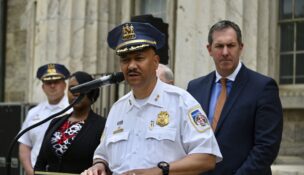Legal Lingo: Justices’ opinions blaze trails in language, graphics
By: Bridgetower Media Newswires//September 14, 2023//
Legal Lingo: Justices’ opinions blaze trails in language, graphics
By: Bridgetower Media Newswires//September 14, 2023//
BOSTON — The Commerce Clause is right there in the U.S. Constitution, authorizing Congress “to regulate commerce with foreign nations, and among the several states, and with the Indian tribes.”
The dormant Commerce Clause does not appear in the Constitution but is implied. And now Justice Neil M. Gorsuch has devised the phrase “the (wakeful) Commerce Clause,” by which he means — the Commerce Clause.
The phrase appears for the first time in a reported decision, in a case issued toward the end of the Supreme Court’s 2022-2023 term.
Justice Gorsuch used the phrase in National Pork Producers Council v. Ross, which let stand a California law that bars in-state sales of pork from pigs that had been confined in a cruel manner. The major issue: Did the law affect interstate commerce in violation of the Commerce Clause?
The majority opinion discussed “what has come to be called the dormant Commerce Clause. Reading between the Constitution’s lines … this Court has held that the Commerce Clause not only vests Congress with the power to regulate interstate trade; the Clause also contain[s] a further, negative command, one effectively forbidding the enforcement of certain state [economic regulations] even when Congress has failed to legislate on the subject.”
In that context, Justice Gorsuch distinguished between the Commerce Clause and the dormant Commerce Clause by writing: “Under the (wakeful) Commerce Clause, that body [Congress] enjoys the power to adopt federal legislation that may preempt conflicting state laws.”
And the point in creating the phrase is what? Has anyone had trouble distinguishing between the Commerce Clause and the dormant Commerce Clause?
Justice Elena Kagan continues to be the breeziest writer on the high bench, but I’m not sure if her catchphrases will become dated — and hard to understand in years to come.
In her dissent to Andy Warhol Foundation for the Visual Arts v. Goldsmith, Justice Kagan used “m.o.” without explaining that it stands for “modus operandi.” In Biden v. Nebraska, the student loan forgiveness case, Kagan dissented: “Today’s decision … moves the goalposts … .”
In the same dissent, Justice Kagan used “tell” as a noun, as in a poker player’s change in behavior or demeanor to reveal the player’s assessment of the strength of a hand. (Think of a “telltale sign.”) Justice Kagan wrote: “The tell comes in the last part of the majority’s opinion.” It may be the first use in a Supreme Court opinion or any reported case of “tell” as a noun. But it’s hard to, well, tell because even searching for “the tell” or “a tell” retrieves uses of “tell” as a verb.
Justice Kagan immediately continued on to another metaphor: “When a court is confident in its interpretation of a statute’s text, it spells out its reading and hits the send button.” In two successive sentences, Justice Kagan evoked poker and email.
What else did Justice Kagan say about the court’s majority? “It blows through a constitutional guardrail intended to keep courts acting like courts.” Four pages later, she objected that the court did not “stay in its lane.”
Justice Amy Comey Barrett, in her concurrence in the same loan-forgiveness case, also used motor vehicle metaphors. She wrote, “We have also pumped the brakes” on decisions by administrative agencies.
Well, not exactly. Pumping the brakes is what a driver does. The Supreme Court, sitting in the passenger’s seat or even in another vehicle, reached its legs across the legs of the administrative agency in the driver’s seat and pumped the brakes for it. Barrett also used “greenlight” as a synonym for “approve.”
“Greenlight” is new in Supreme Court opinions; Justice Kagan used it in dissents in 2021 (Whole Women’s Health v. Jackson) and 2022 (Federal Election Commission v. Cruz). Justice Stephen Breyer also used it in a 2022 dissent (Dobbs v. Jackson Women’s Health Organization).
So far, “greenlight” as a synonym for “approve” carries a whiff of disapproval in Supreme Court decisions; it hints at danger at what greenlighting will bring.
In the student loan forgiveness case, Justice Kagan seemed to initiate a round of conversation using the word “wheelhouse,” meaning the locus of one’s skills or authority. (She used “wheelhouse” twice in her dissent in West Virginia v. EPA in 2022.) In her 2023 dissent, she wrote: “Student loans are in the Secretary [of Education]’s wheelhouse.” Justice Barrett wrote in concurrence that “[a]nother telltale sign that an agency may have transgressed its statutory authority is when it regulates outside its wheelhouse.”
The majority opinion, rebutting Justice Kagan’s argument and putting “wheelhouse” in quotation marks, wrote that “it would seem more accurate to describe the [student loan forgiveness] program as being in the ‘wheelhouse’ of the House and Senate Committees on Appropriations.”
The end-of-term decisions also seemed to be a conversation among justices using the phrase “straw man” and variations on it. What’s a straw man argument? Distorting the argument of one’s opponent so that it is weak or extreme and as easy to knock down as an effigy made of straw. The action connected with a straw man that I’m familiar with is “knock down”: One sets up a straw man for the purpose of knocking it down.
In the 2023 affirmative action case, Students for Fair Admissions v. President & Fellows of Harvard College, Justice Sonia Sotomayor used a different verb. She wrote in her dissent that the majority opinion “attacks a straw man.”
Justice Ketanji Brown Jackson used still a different verb in her dissent. She wrote that Justice Clarence Thomas “ignites too many more straw men to list, or fully extinguish.” (Justice Thomas wrote a concurrence.) Did Justice Brown Jackson expand the idiom on purpose? I don’t know.
“Strawman” is a verb, too. Justice Thomas, in his dissent in a different case, had this to say: “After thus straw-manning Alabama’s arguments at the outset, the majority muddles its own response.” That was in Allen v. Milligan, the electoral redistricting case at the end of the court’s term.
Is it one word or two? “Straw man” and “straw men”? Or “strawman” and “strawmen”? Is it hyphenated? “Straw-man” and “straw-men”? In 2023, the expression was two words in Justice Sotomayor’s dissent in the affirmative action case. In 2022, it was one word in her dissent to Kennedy v. Bremerton School District, the case of the praying high school football coach. It is hyphenated in Justice Thomas’ dissent in the 2023 redistricting case.
Are these the justices’ personal preferences to which the court’s Reporter of Decisions is deferring? Is the Reporter of Decisions changing its institutional mind from case to case, or not paying attention? I don’t know.
The Supreme Court’s end-of-term decisions were notable for things that are not words: bullet points and graphics. In the affirmative action case, Justice Brett M. Kavanaugh used five bullet points in his concurrence. They’ve appeared before in Supreme Court decisions, but they’re rarer than they should be in legal writing.
The majority opinion about Vanity Fair’s use of an Andy Warhol portrait of the late singer Prince included 11 images, including the photograph by the photographer-respondent, Warhol’s purple silkscreen portrait as it ran in Vanity Fair, and a Campbell’s soup can by Warhol. The appendix had 16 images of Prince. Justice Kagan’s dissent contained eight images, including three reclining female nudes, one each by Giorgione, Titian and Edouard Manet. Most of the images in the case’s various opinions were in color.
Another intellectual property case, Jack Daniel’s Properties v. VIP Products, had four photographs. Justice Gorsuch’s plurality opinion in Mallory v. Norfolk Southern Railway Co. had a color graphic detailing the railway’s operations. The appendix to Justice Thomas’ dissent in Allen v. Michigan had 11 electoral district maps. “A picture (or two) … is worth a thousand words,” wrote Justice Kagan in her dissent in the Warhol case.
When I first learned legal writing decades ago, writers who were aware of the power of language to include or exclude made an effort to use “his or her” instead of “his.” It was a significant development in legal and other writing.
With the fairly recent realization (at least by some people) that not every person fits into the binary categories of he or she, the word “they” became the genderless singular pronoun, at least for some. Thus, writing came to mimic colloquial speech in using “they” and its variations to designate an unspecified or generic person.
I’m not saying that the Supreme Court used the singular “they” for the first time in its affirmative action opinion (I don’t read every Supreme Court case), but it is the first time I’ve noticed it. The last substantive paragraph of the opinion states that universities “have concluded, wrongly, that the touchstone of an individual’s identity is not challenges bested, skills built, or lessons learned but the color of their skin.” An individual is a “they.”
Justice Sotomayer also used “they” in the singular. Her dissenting opinion said that the majority opinion “does not identify a single instance where respondents’ methodology has prevented any student from reporting their race with the level of detail they preferred.” “Any student” is a “they” whose possessive pronoun is “their.”
The court majority and some people who laud the opinion see it as an advance, a way to implement a colorblind society. The dissenters and people who decry the opinion see it as a retreat from inclusion. But the subtle language in the majority and a dissenting opinion (whether or not the writers used it on purpose) incrementally advanced inclusion.
Ken Bresler writes about legal and other writing at ClearWriting.com.
Legal News
- Wisconsin attorney loses law license, ordered to pay $16K fine
- Former Wisconsin police officer charged with 5 bestiality felony counts
- Judge reject’s Trump’s bid for a new trial in $83.3 million E. Jean Carroll defamation case
- Dozens of deaths reveal risks of injecting sedatives into people restrained by police
- The Latest: Supreme Court arguments conclude in Trump immunity case
- Net neutrality restored as FCC votes to regulate internet providers
- Wisconsin Attorney General asks Congress to expand reproductive health services
- Attorney General Kaul releases update at three-year anniversary of clergy and faith leader abuse initiative
- State Bar leaders remain deeply divided over special purpose trust
- Former Wisconsin college chancellor fired over porn career is fighting to keep his faculty post
- Pecker says he pledged to be Trump campaign’s ‘eyes and ears’ during 2016 race
- A conservative quest to limit diversity programs gains momentum in states
WLJ People
- Power 30 Personal Injury Attorneys – Russell Nicolet
- Power 30 Personal Injury Attorneys – Benjamin Nicolet
- Power 30 Personal Injury Attorneys – Dustin T. Woehl
- Power 30 Personal Injury Attorneys – Katherine Metzger
- Power 30 Personal Injury Attorneys – Joseph Ryan
- Power 30 Personal Injury Attorneys – James M. Ryan
- Power 30 Personal Injury Attorneys – Dana Wachs
- Power 30 Personal Injury Attorneys – Mark L. Thomsen
- Power 30 Personal Injury Attorneys – Matthew Lein
- Power 30 Personal Injury Attorneys – Jeffrey A. Pitman
- Power 30 Personal Injury Attorneys – William Pemberton
- Power 30 Personal Injury Attorneys – Howard S. Sicula












